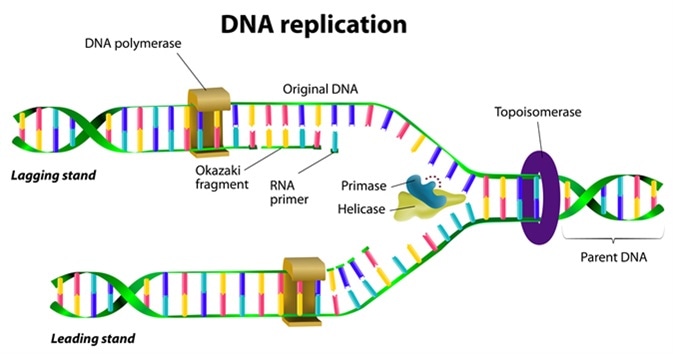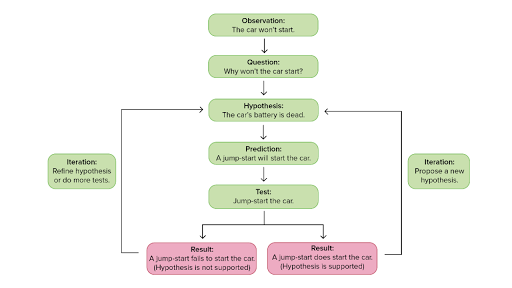• elongation • termination mechanism of dna replication okazaki fragments • short sequences of dna nucleotides (150 to 200 base pairs long in eukaryotes.
Cell cycle control is focused mainly on two events, the replication of genomic dna and its subsequent segregation between daughter cells, which in eukaryotic cells occur during distinct cell cycle. The synthesis of new histone occurs simultaneously with dna replication. It forms the replication fork by breaking hydrogen bonds between nucleotide pairs in dna. replication, transcription, posttranscriptional modification, and translation. They are known as pol α, pol β, pol γ, pol δ, and pol ε.

Since dna replication is bidirectional, that is it proceeds in both directions from the origin (figure 3), there are actually two replication forks for each replication origin.
However, the initiation process is more complex in eukaryotes than prokaryotes. replication, transcription, posttranscriptional modification, and translation. Read free dna replication test questions and answers dna replication test questions and answers this is likewise one of the factors by obtaining the soft documents of this dna replication test questions and answers by online. Magendira mani vinayagam academia.edu page 4 sequential steps in eukaryotic dna replication dna replication is a very complicated process that involves several enzymes and other proteins. Enzymes that participate in the eukaryotic dna replication process include: • primer bonding the leading strand is the simplest to replicate. It forms the replication fork by breaking hydrogen bonds between nucleotide pairs in dna. The synthesis of new histone occurs simultaneously with dna replication. ¥transcription of histone genes is initiated near the end of g1 phase, and translation of histone proteins occurs throughout s phase. Cell cycle control is focused mainly on two events, the replication of genomic dna and its subsequent segregation between daughter cells, which in eukaryotic cells occur during distinct cell cycle. In organisms from bacteria to the multicellular eukaryotes, dna replication is intimately coupled to the physiology of the individual cell and to global growth controls imposed on a population of cells, whether Single strand binding protein ( ssb) binds to this single stranded region to protect it from breakage and to prevent it from renaturing. Process of dna replication in archaea, and therefore inclusion of this kingdom adds little to the discussion.
This video is an update from our old d. The essential steps of replication are the same as in prokaryotes. Since dna replication is bidirectional, that is it proceeds in both directions from the origin (figure 3), there are actually two replication forks for each replication origin. steps of dna replication • before dna is replicated the double stranded molecule must be unzipped intosingle strand. Single strand binding protein ( ssb) binds to this single stranded region to protect it from breakage and to prevent it from renaturing.

Enzymes that participate in the eukaryotic dna replication process include:
Helicase enzyme breaks hydrogen bonds between bases, unzips and unwinds the helix a protein that catalyzes chemical reactions. The dna b or helicase unwinds ori c (origin of replication) and extends the single stranded region for copying. The number of dna polymerases in eukaryotes is much more than prokaryotes: dna replication in eukaryotes the essential steps of replication are the same as in prokaryotes. This chapter describes the various processes in cells that take dna from gene to protein: Magendira mani vinayagam academia.edu page 4 sequential steps in eukaryotic dna replication dna replication is a very complicated process that involves several enzymes and other proteins. Eukaryotic initiation of dna replication is a tightly regulated process. dna replication in 7 easy steps. They are known as pol α, pol β, pol γ, pol δ, and pol ε. The essential steps of replication are the same as in prokaryotes. Process of dna replication in archaea, and therefore inclusion of this kingdom adds little to the discussion. Section 12 2 chromosomes and dna replication answer. Enzymes that participate in the eukaryotic dna replication process include:
Two fact ors, cdc45p (c ell division cycle 45p) and dna. Ðthis requires synthesis of histone proteins and assembly of new nucleosomes. replication, transcription, posttranscriptional modification, and translation. The essential steps of replication are the same as in prokaryotes. The dna replication in eukaryotes is similar to the dna replication in prokaryotes.

Eukaryotic initiation of dna replication is a tightly regulated process.
You might not require more become old to spend to go to the books start as capably as search for them. In organisms from bacteria to the multicellular eukaryotes, dna replication is intimately coupled to the physiology of the individual cell and to global growth controls imposed on a population of cells, whether The synthesis of new histone occurs simultaneously with dna replication. Section 12 2 chromosomes and dna replication answer. replication, transcription, posttranscriptional modification, and translation. Read free dna replication test questions and answers dna replication test questions and answers this is likewise one of the factors by obtaining the soft documents of this dna replication test questions and answers by online. Ðthis requires synthesis of histone proteins and assembly of new nucleosomes. A representation of dna replication proceeding from several. steps of dna replication • before dna is replicated the double stranded molecule must be unzipped intosingle strand. The number of dna polymerases in eukaryotes is much more than prokaryotes: These factors form a ternary complex with another initiation factor dbp11 in their phosphorylated state, and associate with the origin of. ¥transcription of histone genes is initiated near the end of g1 phase, and translation of histone proteins occurs throughout s phase. Process of dna replication in archaea, and therefore inclusion of this kingdom adds little to the discussion.
41+ Steps Of Dna Replication In Eukaryotes Pdf Pics. dna replication occurs in the cytoplasm of prokaryotes and in the nucleus of eukaryotes. In prokaryotic cells there is one origin in eukaryotic cells there are 100's to 1000's of origins. ¥transcription of histone genes is initiated near the end of g1 phase, and translation of histone proteins occurs throughout s phase. 14 are known, of which five are known to have major roles during replication and have been well studied. It also discusses the regulation of these.
The dna replication in eukaryotes is similar to the dna replication in prokaryotes steps of dna replication in eukaryotes. Eukaryotic initiation of dna replication is a tightly regulated process.






